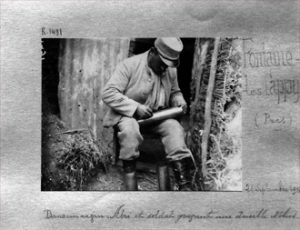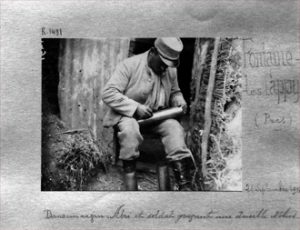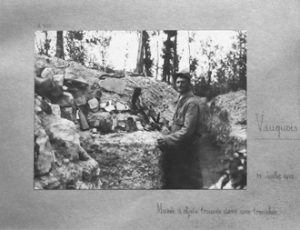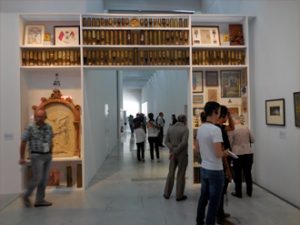
As a historian of anthropological art, Bertrand Tillier studies objects of all sorts manufactured in the trenches by the combatants of all nations who were engaged in the bloody conflict of the Great War. Conscious of the reticence of art historians to include such unclassifiable and disturbing products, he directs his attention toward the visual artist and writer Jean-Jacques Lebel, who, since 1957, has ceaselessly been gathering the inspired do-it-yourself handiwork [bricolages géniaux] of soldiers while telling us that “those who handcrafted [such works] were not professional artists but, rather, ‘temporarily living beings’ who felt the urge to leave behind a trace before altogether disappearing, for they sensed that they were immersed in death.”
Laurence Bertrand Dorléac
Bertrand TillierThe Art of Trenches: Reflections on the gaze of Jean-Jacques Lebel
The introduction, into art history, of objects soldiers manufactured during the Great War out of recovered and altered shell casings merits some reflection. For, their life as objects cut up, hammered, shaped, carved, and engraved by World War I infantrymen [les poilus]—what is ordinarily called trench craftsmanship—is the site of a change in status, from heritage object to artwork, which indicates how they have entered into the field of aesthetic approaches. The history of Great War trench art made out of metal recycled from the industrial armaments of modern warfare (e.g., shell casings, warheads, and driving rings) could, in the company of Jean-Jacques Lebel, open upon a foundational scene:
 It was around seven on a Sunday morning in the Spring of 1957, at the Saint Ouen flea market, where I was drifting along [dérivais] in the company of André Breton—the exemplary strolling researcher—that I was put into the presence of a brass object around twenty centimeters high and fifteen in width, all of a piece on a circular base, and pierced by three oval-shaped orifices. At first sight, it resembled a bird’s head. Intrigued, I bought it for the exorbitant sum of two old francs and brought it home. . . . Neither Breton nor I had the foggiest notion of what purpose this unusual object might have served.1
It was around seven on a Sunday morning in the Spring of 1957, at the Saint Ouen flea market, where I was drifting along [dérivais] in the company of André Breton—the exemplary strolling researcher—that I was put into the presence of a brass object around twenty centimeters high and fifteen in width, all of a piece on a circular base, and pierced by three oval-shaped orifices. At first sight, it resembled a bird’s head. Intrigued, I bought it for the exorbitant sum of two old francs and brought it home. . . . Neither Breton nor I had the foggiest notion of what purpose this unusual object might have served.1
This conjuring up of the past is implicitly based on another mythic moment, wherein Breton acted as memoirist for an episode in L’Amour fou (1937). There, Breton was describing his first “found object,” discovered during one of his flea-market wanderings while in the company of Alberto Giacometti: “a half-mask of metal striking in its rigidity as well as in its forceful adaptation to a necessity unknown to us,” which “attracted us, drawing us as something we had never seen.” The object was later revealed to be the prototype for one of the first World War I gas masks, Breton seeing therein an emblematic sign of the “death instinct.”2 As if echoing these pages from Breton, Lebel continues the multistage narrative of his own discovery, also rooted in World War I history:
It was only much later that, in coming back to it, I noted that it was a 75cm shell casing and that the three orifices were intended to receive three trimmed photos held in place by rods. This was the beginning of a long artistic adventure and several decades of gathering such items [collectes] at flea markets, rummage sales, and junk shops not only across Europe but also in North America, Canada included.3
In a few lines, Lebel captures the barbarous strangeness of these objects, which do not fit into most classifications and taxonomies, and invests them with a polysemy that was concealed both by their status as anonymous productions (ones having no known author and no possible attribution) and by their reputation as objects that are as kitschy and superannuated as they are countless, their inferior rank having long reduced them to their material value as scrap metal.
These finely worked shell casings and reconverted objects [done by soldiers] were either sent by the post to their addressees (fiancé, parents, children, friends) or brought back from the front by survivors in their kit packs. They adorned mantlepieces—of farms, shacks, and rectories, as well as of bourgeois residences—for a generation or two and later served as vases on the graves of World War I infantrymen or of their descendants, in the cemeteries of Europe. . . . When the leases on burial plots expired, these shell casings were tossed into the garbage or sold off, based on the weight of their brass or copper content, at the going rate on the metals market. They were subsequently rediscovered in flea markets and secondhand shops.4
Between waning memory and outmoded object, these objects, thought to crystallize the mentality of war veterans, have become the exclusive concern of collectors, who have continued to snap them up amid general indifference on the part of art historians.
In the cycles and timelines that affect the popular trench art Lebel describes, and which he defines as so many different destinies (from memorabilia to relics and from collectors’ objects up to and including national heritage items), changes have occurred that redefine the value of these artefacts once produced in unprecedented proportions by masses of men subjected to the extreme brutality of a long, anonymous, technologically-based war—a war that became bogged down in the games played by the general staffs of various military powers determined to hold positions, no matter how bored and idle soldiers might have become. It is under the influence of this reading that Lebel has served less as a traditional collector than as a gatherer [a moins collectionné que collecté]—the artist insists upon this distinction, which allows him to compare his approach to that of an anthropologist—of thousands of shell casings that have been cut up, engraved, carved, and thereby transformed.
 If you read . . . the correspondence of thousands of unidentified soldiers, you’ll see that such objects are often mentioned. Words are lacking to describe the level of terror and anxiety those people endured, literally drowning in shit and soaked up to the neck in death. From this context of trench warfare from the years 1914 to 1918 arise some casings engraved with a nail, a pocketknife, or a bayonet tip, and it doesn’t matter which side these people were on, French, German, British, Italian, Belgian, or from some other nation’s army. They are S. O. S. messages in a bottle. Those who handcrafted [ont bricolé] them were not professional artists but, rather, “temporarily living beings” who felt the urge to leave behind a trace before altogether disappearing, for they sensed that they were immersed in death. Leaving behind a trace—ultimately, that’s what art is all about. That is to say, “staring down death,” engraving an object of military origin in order to say “something human occurred here.” . . . how many millions of unknown soldiers, on either side of the front lines, left no other trace than engraved shell casings or aluminum rings?5
If you read . . . the correspondence of thousands of unidentified soldiers, you’ll see that such objects are often mentioned. Words are lacking to describe the level of terror and anxiety those people endured, literally drowning in shit and soaked up to the neck in death. From this context of trench warfare from the years 1914 to 1918 arise some casings engraved with a nail, a pocketknife, or a bayonet tip, and it doesn’t matter which side these people were on, French, German, British, Italian, Belgian, or from some other nation’s army. They are S. O. S. messages in a bottle. Those who handcrafted [ont bricolé] them were not professional artists but, rather, “temporarily living beings” who felt the urge to leave behind a trace before altogether disappearing, for they sensed that they were immersed in death. Leaving behind a trace—ultimately, that’s what art is all about. That is to say, “staring down death,” engraving an object of military origin in order to say “something human occurred here.” . . . how many millions of unknown soldiers, on either side of the front lines, left no other trace than engraved shell casings or aluminum rings?5
With these statements, Lebel is defending the idea that, whatever the circumstances, art must oppose death, which it resists, and that art goes beyond death in order to vanquish it. In this way of laying things out, trench art, however modest and basic, nay even clumsy it might be, crystallizes History, of which it is a sign, for, despite its handicraft status [statut de bricolage] that derives from working the scraps of war, it is a manifestation of the invincibility of art.
From trench craftsmanship to art: within this change in status that affects the artefacts of World War I soldiers, a process of artification develops, in the sense defined by Roberta Shapiro: “the transformation of a modest, everyday practice . . . into an activity instituted as art and defined as a new genre.”6. Lebel’s singular reading is an expression thereof, as is his dual activity of collectage and montrage7 of shell casings and of other such finely worked objects. As part of his 2009 Soulèvements (Uprisings) exhibition at the Maison Rouge in Paris, Lebel brought together 1093 trench objects from his “gathering” and presented them in the form of an installation. Apropos of this environment in which the objects were juxtaposed on racks of shelves arranged into a “wall,” the artist explains:

Installation par Jean-Jacques Lebel en hommage aux poilus anonymes lors de l’exposition Les désastres de la guerre. 1800-2014 au Louvre-Lens, 2015.
To show them together is therefore to abolish nationalisms and frontiers. In the installation I have constructed, what I am trying to offer is a simultaneously analytical and oneiric look at objects that are evocative of human monstrosity and of the desperate efforts of thousands of miserable guys in the trenches who were awaiting death or who had already been turned into cadavers, so as to enshrine the horror of war and to conjure it away.8
The transgression of boundaries, which occupies Lebel’s mind, also acts in a symbolic way on these artefacts borrowed from the past that have been displaced both temporally and within the social field in order to be the object of a contemporary artistic approach and political intervention. In this way, Lebel has entered these indistinct objects into the history of twentieth-century avant-garde artistic movements in accordance with a process that was reinforced by the presentation of this same installation at the Pompidou Center-Metz’s 2012 exhibition 1917 in a “more extensive, more massive” format that was “more focused on the details of each object.”9 The walls of finely worked shell casings presented at this arts event were designed to “enter into dialogue and into play” with “some masterworks of 1917”10 —and in particular with Constantin Brâncuşi’s Princess X (1915-1916, French National Museum of Modern Art), exhibited opposite Lebel’s installation, with which it could (almost) be confused: the same dynamic of condensation and metaphor, an identical verticality, similar erotic and phallic charge, same polished-bronze visual effect with its reflective properties.
Lebel therefore is transmuting the products of infantrymen’s craftsmanship into artwork. The soldier, an “anonymous do-it-yourselfer [bricoleur anonyme],” appears to him to be “a great artist, sunk into oblivion, whose identity remains unknown and whose work proves worthy of our admiration.”11 Echoing the infantrymen’s approach, Lebel sets his own approach within an economy of recovery and recycling, of détournement and assemblage, that has been a driving force of twentieth-century art from Dada (Marcel Duchamp, Francis Picabia, Kurt Schwitters) to 1950s “junk sculpture.”12 As Lebel asserts,
Certainly, no direct causal connection can be established between the activities of do-it-yourself infantrymen and the Dadaists, and quite likely they had no knowledge of each others’ existence. It would be a matter, rather, of an enigmatic concomitance that may be said to have operated in the mode of rhizomatic correspondences occurring without the knowledge of the principal interested parties.13
According to the artist, the systematic reuse and methodical conversion of the industrial scraps of modern warfare by do-it-yourself soldiers—bricolage used here as Claude Lévi-Strauss defined it in the now-classic pages of The Savage Mind14 —may be said to have clandestine connections with the visual-arts practices of avant-garde movements.
In the aesthetic values Lebel attaches to trench art, such art is “a genuine anonymous artifact [objet d’art brut], in the full sense of the term,”15 and the polysemy of this term brut is not to be underestimated. No doubt, the artist is thus hailing, by extension, the raw [brute] expressiveness characteristic of infantrymen art, whose qualities were to be explored by avant-garde artists called up during the conflict—as with Fernard Léger, who confessed to having received in the trenches a revelation about objects and their visual-arts power: “I was dazzled by a breechblock of a 75mm gun opened in the sun, the magic of light on polished metal. . . . The breechblock. . . taught me more for my artistic education than all the museums in the world,” he declared.16 In all likelihood, Lebel is also thinking of the kinship between trench art and outsider art [l’Art brut], a term invented later on by Jean Dubuffet at the end of World War II to designate naive and disconcerting visual-arts productions made at the margins of society on the basis of gathered objects or rudimentary techniques, outside the norms of the fine arts, by individuals unscathed by any artistic education who generally are lacking an awareness that they are artists. “They make art without knowing it; they do not know that they are artists,” Lebel explains apropos of these World War I soldiers.17
In the radicalness of the acts and intentions involved in Lebel’s gathering, bringing together, and exhibition of an imposing set of finely worked World War I shell casings, there is the idea of a kind of art that is executed without the knowledge of those who have steadfastly practiced this art, and whose full artistic status, though forgotten or neglected, the artist endeavors to reveal. Having recalled that, as early as 1915 and throughout the War, exhibitions of objects and artworks manufactured by infantrymen were organized in France and in Germany near the zones of combat as well as in Paris and Berlin, Lebel underscores the fact that this “artistic label” was later abandoned, “relegating the infantrymen’s efforts to the category of craftsmanship”18 and assigning them to a minor rung in the hierarchy of the arts, “as was, moreover, long the case of the primitive arts and art brut.” And in exhortatory fashion, Lebel says: “Such is the tendency that today is to be overturned in light of a less academic and less restrictive definition of what constitutes a work.”19
Certainly, shell casings that have been picked up and recycled so as later on to be reworked or polished into jewelry and other finery by the soldiers of the Great War have a palpable content of their own as well as a historic import and an anthropological signification that can be investigated. Yet the aesthetic value that, as artist-smuggler, Lebel attributes to these finely worked pieces and to trench jewelry results from artistic developments that art history has not yet legitimated on account of its reluctance to embrace fully the social field of art, up to and including its popular practices and forms of experimentation.
Notes
1 Jean-Jacques Lebel, “Une concomitance énigmatique,” in the Centre Pompidou-Metz’s 2012 exhibition catalog 1917, pp. 48-53 (see p. 52 for the quotation).
2 André Breton, Mad Love, trans. Mary Ann Caws (Lincoln: University of Nebraska Press, 1987), pp. 28 and 38.
3 Lebel, “Une concomitance énigmatique,” p. 52.
4 Ibid., p. 51.
5 Jean-Jacques Lebel, “Art as Upheaval” (interview with Jean de Loisy), trans. David Ames Curtis, in the Soulèvements. Jean-Jacques Lebel exhibition catalog (Paris: La Maison Rouge; Lyon: Fage Éditions, 2009), pp. 215-16.
6 Nathalie Heinich and Roberta Shapiro, ed., De l’artification. Enquêtes sur le passage à l’art (Paris: Éditions de l’EHESS, 2012), p. 17.
7 Lebel, “Art as Upheaval,” p. 37.
8 Lebel, “Art as Upheaval,” p. 215.
9According to the words of Lebel, “Une concomitance énigmatique,” p. 52.
10 Ibid.
11 Ibid., p. 48.
12 These various forerunners are mentioned by the artist himself (ibid., pp. 48-53).
13 Ibid., p. 49.
14 Claude Lévi-Strauss, The Savage Mind (1962; Chicago: University of Chicago Press, 1966).
15Lebel, “Art as Upheaval,” p. 215.
16 Quoted by Werner Schmalenbach, Fernand Léger, trans. Robert Allen with James Emmons (New York: Harry N. Abrams, Inc., 1976), p. 20.
17December 28, 2010 interview of Jean-Jacques Lebel conducted by Nadia Kabbach; reproduced in Nadia Kabbach, L’art des tranchées. Un art de détournement de masse, History of Contemporary Art Master’s thesis, University of Paris-1 Panthéon-Sorbonne, 2011 (Philippe Dagen, thesis advisor).
18 “Une comitance énigmatique,” p. 49.
19Ibid.
Bibliography
DURAND, Nicole. De l’horreur à la l’art. Dans les tranchées de la Première Guerre mondiale. Paris: Seuil, 2006.
1917. Exhibition catalog. Metz: Centre Pompidou-Metz, 2012.
SAUNDERS, Nicholas J. Trench Art: Materialities and Memories of War. Oxford, England and New York: Berg, 2003.
Soulèvements. Jean-Jacques Lebel. Exhibition catalog. Paris: La Maison Rouge; Lyon: Fage Éditions, 2009.
WARIN, Patrice. Artisanat de tranchée & Briquets de poilus de la guerre 14-18. Louviers: Ysec Éditions, 2001.
_____. Artisanat de tranchée de la Grande Guerre. Louviers: Ysec Éditions, 2005.
Docteur de l’Université Paris-1 Panthéon-Sorbonne où il a été maître de conférences (2000-2009), Bertrand Tillier est professeur d’histoire de l’art contemporain à l’Université de Bourgogne et directeur du Centre Georges Chevrier (UMR CNRS 7366). Historien de la caricature à laquelle il a consacré plusieurs ouvrages, il s’intéresse aussi à la réception critique et à l’historiographie de l’art. Ses travaux interrogent en particulier les rapports entre les arts et la politique aux XIXe et XXe siècles, dans la perspective d’une histoire culturelle et sociale des imaginaires et des sensibilités. Conseiller scientifique et commissaire d’exposition, il co-dirige la revue Sociétés & Représentations (Publications de la Sorbonne).
